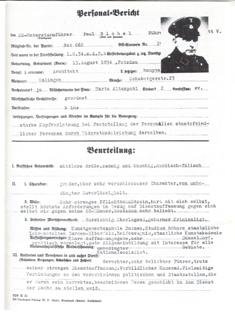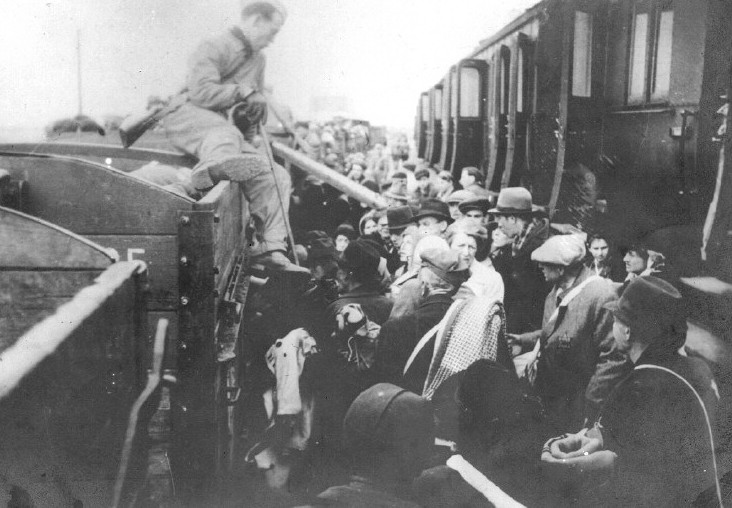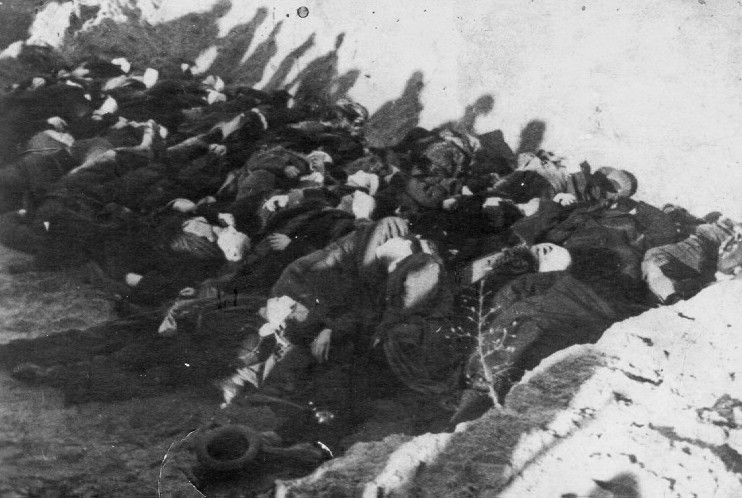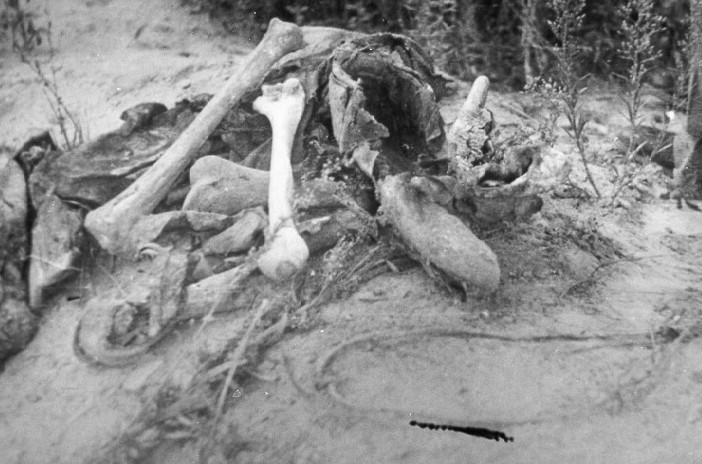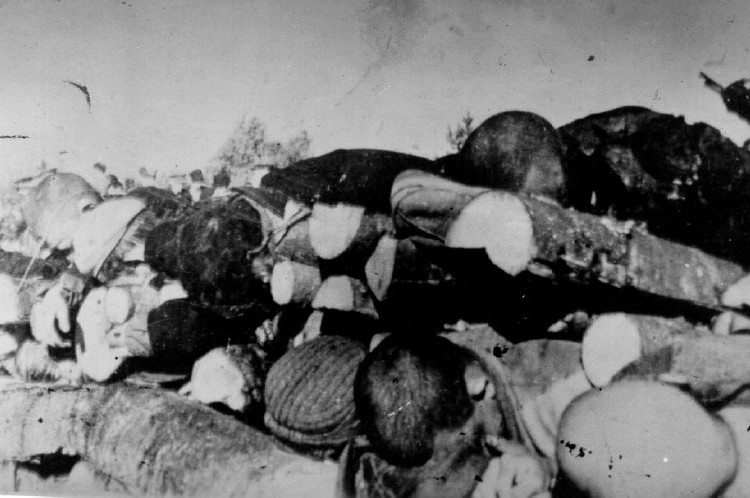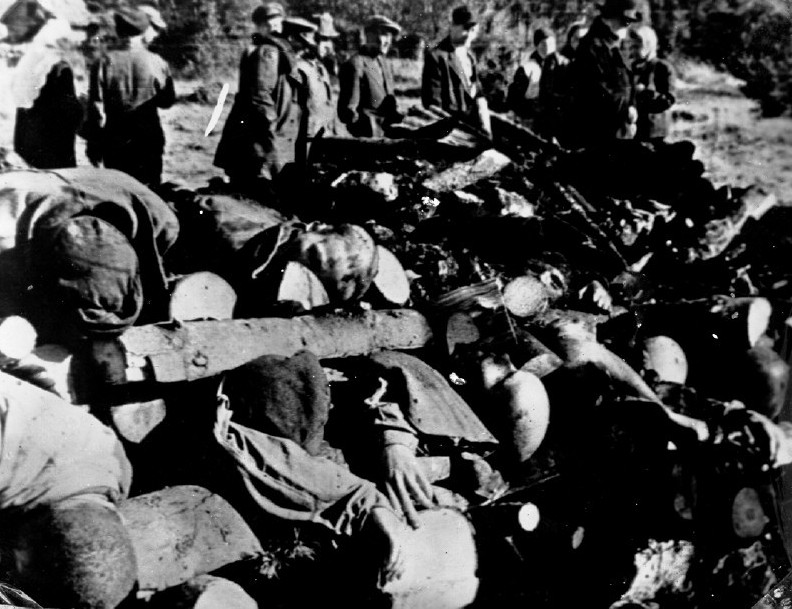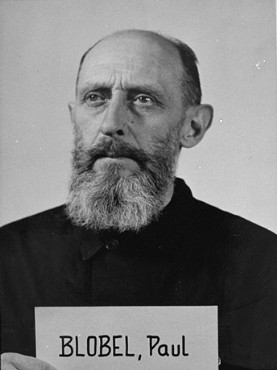Holocaust Education & Archive Research Team |
|
Einsatzgrϋppen
Einsatz Group A Einsatz Group B Einsatz Group C Einsatz Group D Babi Yar Articles Einsatz Leaders Einsatzgruppen Operational Situational Reports [ OSR's #8 - #195 ]
| ||||||||||||||||||||||||||||||||||||||||||||||||||
Paul Blobel
Einsatzgruppen Commander Sonderkommando 1005
Paul Blobel was born on 13 August 1894 in Potsdam. He served in First World War where he was awarded the Iron Cross First Class. After the Great War Blobel studied architecture and practised this profession from 1924 until 1931 upon losing his job he joined the Nazi Party and the SS on 1 December 1931.
Following the German invasion of the Soviet Union Blobel took command of Einsatzkommando 4a of Einsatzgruppe C that operated in the Ukraine. As well as shooting the Nazis murdered Jews in gas-vans, Eimsatzgruppe C was issued at least five gas vans and gave two to Sonderkommando 4A, two to Einsatzkommando 6 and one to Einsatzlommando 5.
A member of the group testified after the war:
Two gas vans were in service I saw them myself. They drove into the prison yard, and the Jews – men, women and children – had to get straight into the vans from their cells.
I know what the interior of the vans look like. It was covered with sheet metal and fitted with a wooden grid. The exhaust fumes were piped into the interior of the vans. I can still hear the hammering and the screaming of the Jews – “Dear Germans let us out!”
The Jews went through our cordon and into the van without hesitating. As soon as the doors were shut, the driver started the engine. He drove to a spot outside Poltava. I was there when the van arrived.
As the doors were opened, dense smoke emerged, followed by a tangle of crumpled bodies. It was a frightful sight. The driver for Paul Blobel, testified after the war regarding the unloading of one of these gas-vans:
The use of the gas vans was the most horrible thing I have ever seen. I saw people being led into the vans and the doors closed. Then the van drove off. I had to drive Blobel to the place where the gas vans were unloaded.
The back doors of the van were opened, and the bodies that had not fallen out when the doors were opened were unloaded by Jews who were still alive. The bodies were covered with vomit and excrement. It was a terrible sight. Blobel looked then he looked away, and we drove off, on such occasions Blobel always drunk schnapps, sometimes even in the car.
Blobel organised the infamous massacre of 33,771 Kiev Jews which took place in the Babi Yar ravine, the Einsatzgruppen reports give the full credit for the massacre to Blobel, but at the War Crimes Trial in Nuremburg Blobel protested his absence from Kiev, and declared further that only fifteen of his fifty-three men could be detailed for the executions.
In March 1942 Albert Hartel, a Gestapo expert on church affairs, was driving with Blobel towards a country villa outside Kiev used by Brigadefuhrer Thomas, the Higher SS and Police Leader. At the Babi Yar ravine, Hartel noticed small explosions, which threw up columns of earth. It was the thaw, releasing the gases from thousands of bodies, and Blobel explained – “Here my Jews are buried.”
But Blobel was not quit of the affair. Two months later he was sent for in Berlin by Heydrich who was about to leave for Prague and his own death. After the passage of more than five years, the words of that steel –faced young man were still indelibly stamped on the memory of the Nuremburg defendant:
“Well you have developed a stomach. You are just a cissy, only fit to be employed as porcelain –manufacturer – but I will push your nose much deeper into it. You will report to Obergruppenfuhrer Muller.” Henceforward Blobel’s unique assignment was to destroy the traces of mass burials in Poland and Russia. Blobel was in Chelmno in September 1942 and in the following June he was back in the Babi Yar ravine, where his knowledge and experience showed the exhumation squad where to dig.
Returning to Chelmno, after his appointment Blobel along with a small staff of three or four men, began experimenting with systems for burning bodies. The place chosen for these experiments was Chelmno, the first death camp that had been established and had been operating since the end of 1941.
Jews from the Lodz area had already been gassed at Chelmno in gas-vans and buried in pits in a nearby forest. The pits were opened, and the first experiments were carried out. Incendiary bombs were tried, but these caused large fires in the surrounding woods.
Then they started to cremate the bodies on wood in open fireplaces. The bones that remained were destroyed by a special bone-crushing machine. The ashes of the bodies and small fragments of bones were buried in the pits from which the bodies had been removed.
At the conclusion of these successful experiments the SS had found a simple and efficient way to erase their crimes. Hoess the commandant from Auschwitz visited Blobel at Chelmno, to witness the techniques being used there to dispose of the corpses.
The results of Blobel’s experiments were sent to Odilo Globocnik so that he could introduce cremation of the corpses in Belzec, Sobibor and Treblinka, but Globocnik did not like the idea, and was slow in doing so, but Himmler’s orders that no traces of mass murder should be left, gave him little choice, in this matter.
Stangl the camp commandant in Treblinka relates:
It must have been at the beginning of 1943 – that’s when excavators were brought in. Using these excavators the corpses were removed from the huge ditches which had been used until then for burial.
The old corpses were burned on the roasters, along with the new bodies (of new arrivals to the camp). During the transition to the new system Wirth came to Treblinka. As I recall Wirth spoke of a Standartenfuhrer who had experience in burning corpses. Wirth told me that according to the Standartenfuhrer’s experience, corpses could be burned on a roaster, and it would work marvellously.
I know that in the beginning in Treblinka they used rails from the trolley to build the cremation grill. But it turned out that these were too weak and bent in the heat. They were replaced with real railroad rails. That Standartenfuhrer was Paul Blobel.
At his trial Blobel described the process of exhuming and erasing the Nazi crimes:
“I myself witnessed the burning of corpses in a mass grave near Kiev during my visit in August 1943. This grave was about 55 meters long, 3 metres wide and 2 and half meters deep.
When the cover had been lifted, the bodies were covered with fuel and set on fire. It took about two days for the grave to burn down. I myself saw that the grave became red-hot right down to the ground.
Afterwards the grave was filled in, and thus all traces were as good as eliminated. Owing to the approach of the front, it was not possible to destroy the mass graves further to the south and the east, resulting from the executions of the Einsatzgruppen.
Sonderkommando 1005
The units code name originated in a letter from Gestapo chief Heinrich Muller to Deputy Foreign Minister Martin Luther. The letter relayed an anonymous complaint concerning corpses in the Warthegau district. The letter received a file number – in this case 1005 – and it was from this number that subsequent instructions were undertaken.
The task commenced in June 1942 when SS- Standartenfuhrer Paul Blobel was appointed to head up Operation 1005. Not all Einsatzgruppe commanders were enthused with the project SS- Gruppenfuhrer Dr Max Thomas of Einstazgruppe C called the mission “the task of fools.”
From its commencement of operations Sonderkommando 1005’s task was to conceal Nazi crimes commited at Einsatzgruppen sites, several thousand Jews and other prisoners did the heavy physical work of exhuming and burning the corpses, after which they too were executed and their bodies burned.
Their activities got into full swing in the spring of 1943 working at the Einsatzgruppen execution sites in the three Army Group areas (North, Centre and South).
In the Ukraine, Blobel organised two subordinate units Sonderkommando 1005A and Sonderkommando 1005B. The units worked at Babi Yar (Kiev) and Dnepropetrovsk, as well as Berdichev, Unman and Nikolayev. At Minsk, Blobel’s deputy Karl Harder organised an additional unit, Sonderkommando 1005 – Mitte. This unit operated in Byelorussia. Other Sonderkommando 1005 units saw work in the Baltic States. Most of the German personnel in the Sonderkommando were assembled in Salzburg, Austria in October 1944 when 1005 was disbanded and re-assigned under the command of Blobel – to Einsatzgruppe Iltis to fight Yugoslav partisans in the area of Carinthia. Sonderkommando 1005 Officers
Paul Blobel was tried at Nuremburg in April 1948 in the so-called The Einsatzgruppen Case (Case No 9) and was executed at Landsberg prison on the 8 June 1951.
Sources:
The Field Men by French L. MacLean, published by Schiffer Military History Atglen PA 1999 PRO Archives The Final Solution by G. Reitlinger, published by Vallentine and Mitchell and Co Ltd 1953 GFH USHMM
COPYRIGHT: CW & CL H.E.A.R.T 2007
|
